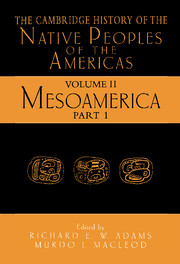Book contents
- Frontmatter
- Contents
- List of Illustrations
- Part I
- 1 Introduction to a Survey of the Native Prehistoric Cultures of Mesoamerica
- 2 The Paleoindian and Archaic Cultures of Mesoamerica
- 3 The Preclassic Societies of the Central Highlands of Mesoamerica
- 4 The Precolumbian Cultures of the Gulf Coast
- 5 The Maya Lowlands: Pioneer Farmers to Merchant Princes
- 6 The Central Mexican Highlands from the Rise of Teotihuacan to the Decline of Tula
- 7 Western and Northwestern Mexico
- 8 Cultural Evolution in Oaxaca: The Origins of the Zapotec and Mixtec Civilizations
- 9 The Southeast Frontiers of Mesoamerica
- 10 The Maya Highlands and the Adjacent Pacific Coast
- 11 The Aztecs and Their Contemporaries: The Central and Eastern Mexican Highlands
- Index
7 - Western and Northwestern Mexico
Published online by Cambridge University Press: 28 March 2008
- Frontmatter
- Contents
- List of Illustrations
- Part I
- 1 Introduction to a Survey of the Native Prehistoric Cultures of Mesoamerica
- 2 The Paleoindian and Archaic Cultures of Mesoamerica
- 3 The Preclassic Societies of the Central Highlands of Mesoamerica
- 4 The Precolumbian Cultures of the Gulf Coast
- 5 The Maya Lowlands: Pioneer Farmers to Merchant Princes
- 6 The Central Mexican Highlands from the Rise of Teotihuacan to the Decline of Tula
- 7 Western and Northwestern Mexico
- 8 Cultural Evolution in Oaxaca: The Origins of the Zapotec and Mixtec Civilizations
- 9 The Southeast Frontiers of Mesoamerica
- 10 The Maya Highlands and the Adjacent Pacific Coast
- 11 The Aztecs and Their Contemporaries: The Central and Eastern Mexican Highlands
- Index
Summary
INTRODUCTION
Until recently, Western and Northwestern Mexico had been regarded as a backwater of Mesoamerica. Ironically, though not unexpectedly, the Aztec view, chauvinist as it was and should have been, was adopted by the conquistadores and succeeding generations of Spaniards, Mexicans, and ultimately by the worldwide scholarly community. That view placed the Aztecs and their cultural antecedents in Central Mexico at the center of Mesoamerican studies. By comparison Western and Northwestern Mexico was little studied, and when it was, the primary objective was to relate it to Central Mexican culture history and development. The result was that these investigations, having been designed for another purpose, were too fragmentary to delineate western and Northwestern Mexican culture history or its developmental progression. Based on the fragmentary data that had emerged, Western and Northwestern Mexico was considered comparatively simple and therefore not Mesoamerican. When later investigations revealed a high culture and complex society, archaeologists, driven by the Central Mexican model as defining Mesoamerica, again declared Western and Northwestern Mexico as not Mesoamerican; this time because it did not follow the variant form of civilization that existed in Central Mexico.
Since the 1970s, archaeologists have worked more extensively in Western and Northwestern Mexico and have realized that this subarea has a complicated and complex history and development. A number of scholars have come to the conclusion that the definition of Mesoamerican high culture should be based on the range of cultural manifestations in an interactive area and should not be constrained by current political boundaries or internalist interpretations of past culture history. With the con tinuing aggregation of data from and unfettered interpretations of Western and Northwestern Mexico, the concept of Mesoamerica is being amended to the benefit of the archaeological understanding of civilization. The concept that integrates Western and Northwestern Mexico refers to the full manifestation of civilization in Middle America as Greater Mesoamerica.
There has been some attempt to define the boundaries of Western and Northwestern Mexico. Western Mexico ranges from about 26° north to 17° north. The western border is defined by the coastline, and the eastern border undulates around the 101° west longitude line. The states either whole or in part that constitute Western Mexico are Sinaloa, Durango, Nayarit, Zacatecas, Jalisco, Guanajuato, Michoacan, and Guerrero. Northwestern Mexico consists of parts of Jalisco, Durango, Zacatecas, Chihuahua, and Sonora. There is no consensus as to the regions within this subarea.
- Type
- Chapter
- Information
- The Cambridge History of the Native Peoples of the Americas , pp. 318 - 357Publisher: Cambridge University PressPrint publication year: 2000
- 13
- Cited by



